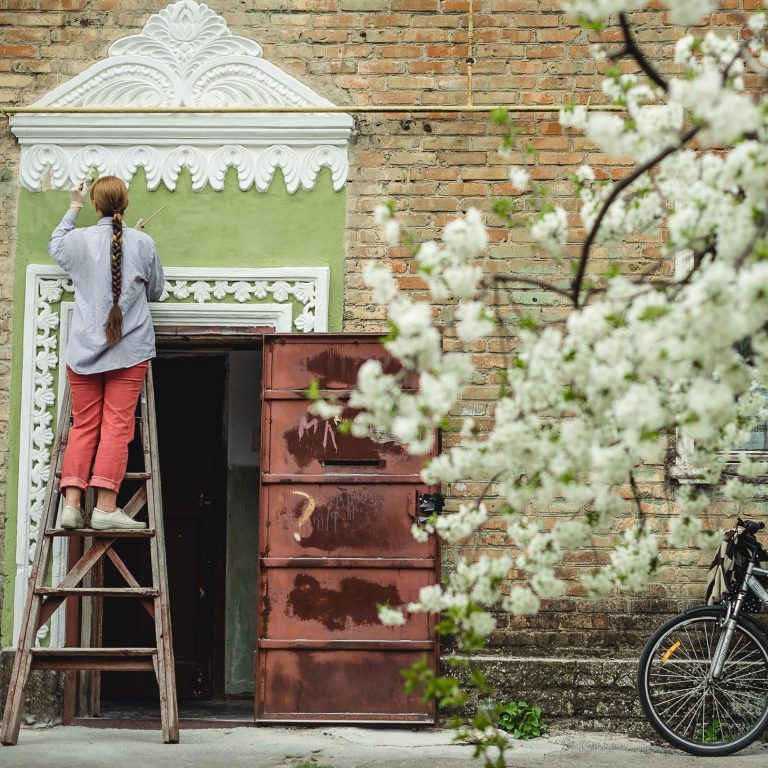Nova Kakhovka is a young town in the north of Tavria, built in the 1950s for the builders of the Kakhovka hydroelectric complex. All the buildings here were built to a unified plan, constructed in haste, and they turned out to be monotonous and unexceptional. Then Hryhorii Dovzhenko, an artist and a follower of the Boichukist school, came to the town. Together with his colleagues, Dovzhenko created 80 unique carved panels which would come to decorate the walls of every building and change the face of the town. Later the Soviet press would criticise Dovzhenko for “architectural excesses”. Today his pieces are considered to be an artistic phenomenon which contemporaries named “stone vyshyvankas”. These days, the ornaments are under threat — not just from the passage of time, but from building insulation and the “modernisation” of the facades as well. Thanks to the actions of local activists, however, the “stone vyshyvankas” are gradually being restored to the town.
Vyshyvanka
A traditional Ukrainian embroidered shirt with embroidery.Film about the construction of the Kakhovka Hydro Power Plant (HPP) and Nova Kakhovka, “A Poem About the Sea” came out in 1958. A few years prior to the release, when a well-known writer and film director, Oleksandr Dovzhenko, visited the town to write a script for the future film, he was stunned by how grey and gloomy the buildings looked. It was his written request to the Academy of Architecture that brought to the newly built settlement a group of artists and architects, who took to decorating the facades with enthusiasm. Hryhorii Dovzhenko was one of them. The artisans worked until 1955, during which time they managed to ornament every building in the town: from residential homes to schools and administrative buildings — some 180 structures in total. Using Dovzhenko’s sketches, unique ornaments were created, with no two designs being the same.

The artist’s works embodied the main ideas of the Boichukists (artists and monumentalists, students and followers of Mykhailo Boichuk — Auth.). This manifests in simplicity and uniformity of traditional shapes, interlaced patterns with depictions of birds and plants, as well as in the idea of popularising Ukrainian art and combining beauty with routine.
Other artists worked on the project alongside Dovzhenko — his son Taras and several Boichukists, Oleksandr Myzin among them. All of the ornaments turned out to be as hard as a stone, and thus remain largely undamaged to this day. The secret to their strength lies in a special stucco compound that Dovzhenko has patented and used in creating these pieces. Painting over damp plaster based on polyvinyl chloride synthetic resins proved to be of significant help to the artisans, as this compound took longer than usual to harden.
Articles about Nova Kakhovka published by the Soviet media after 1955 describe Dovzhenko’s ornaments as unnecessary embellishments. Now, however, they carry the status of an architectural landmark and are under the local community and activists’ protection.

The Initiative
Architect Tetiana Yevseieva moved to Nova Kakhovka from Russia in 1986. She tells that she first read about Nova Kakhovka in a history textbook, while studying architecture at the university, and that it was used as an example of a town built to a unified plan. When the question of demolishing the old town arose, Tetiana and other activists came together to preserve the unique architectural forms. Thus, in 2011, they founded the Society for the Protection of Cultural Heritage of Nova Kakhovka, with the preservation of Dovzhenko’s pieces and the promotion of his work as one of the NGO’s main goals. Tetiana herself serves as the head of the organisation, and Diana Ivannikova as her deputy. Tetiana’s occupation influenced her decision to take up this task — as an architect, she understands the importance of Nova Kakhovka’s ornaments like no one else.
— I felt sorry for these buildings. There’s a district where the new residential buildings have already been built, while these beautiful buildings were being set on fire and demolished to make room for boxes of autoclaved aerated concrete lined with styrofoam and reinforced plastic. This is truly an architectural marvel, and, in the 1980s, it had already been listed as a historic settlement. For some reason, people could appreciate it then, but now we’ve forgotten this, even though it’s a world-class landmark.

Tetiana is convinced that the ornamental panels deserve to be recognised as landmarks of national importance. Together with her colleagues, she is preparing the documents to have this landmark registered, since it is the only one of its kind in southern Ukraine.

Stone vyshyvankas
Tetiana and other activists have thought about this initiative for a long time. They had numerous discussions about the ornaments and the organisation’s program. But their crucial moment came when the name was born—“stone vyshyvankas”.
The name first appeared in 2015, during a collective discussion between the NGO’s members. There were several options, but it was this one that they chose — it conveyed the meaning to architects, tourists, and appealed to the locals. Indeed the ornaments share a resemblance with traditional Ukrainian embroidery.

Each and every frame is unique; there are no repeating patterns. According to Tetiana, such carving took a titanic effort from the artists.
— I remember that everyone who came to Nova Kakhovka was impressed. All the little houses stood so white, there was a lot of greenery and flowers around, and the ornaments shone. Beneath them the artists put a foundation that varied in intensity and colour: purples, greens and lilacs, while the image itself looked like white knitting. Many said that the town looked as though covered in lace.
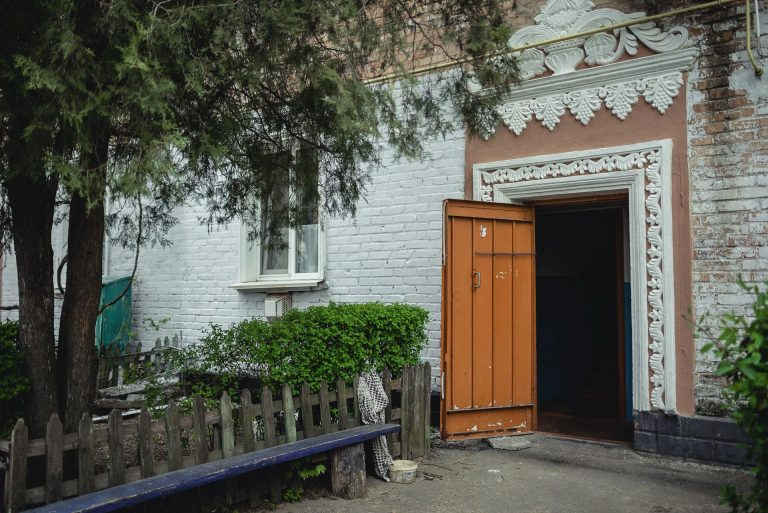
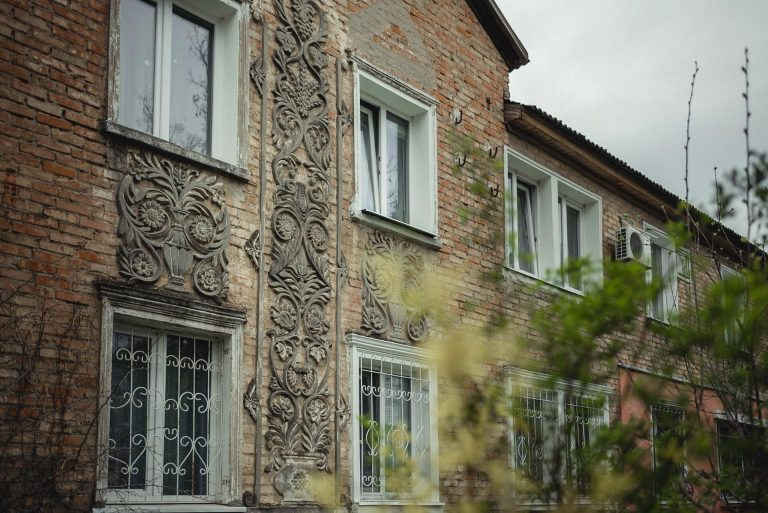
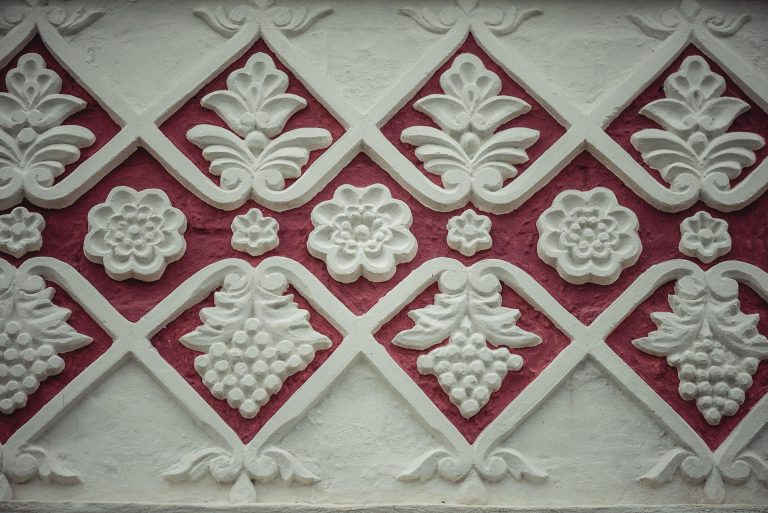
slideshow
The stones mostly depict floral patterns and reproduce elements of the Ukrainian vyshyvanka. Here, there are inimitable vases and kumantsi (ornamental ceramic vessels — a form of traditional Ukrainian dishes — Auth.), and the so called “trees of life”, from which sunflowers, corn and ears of wheat grow.
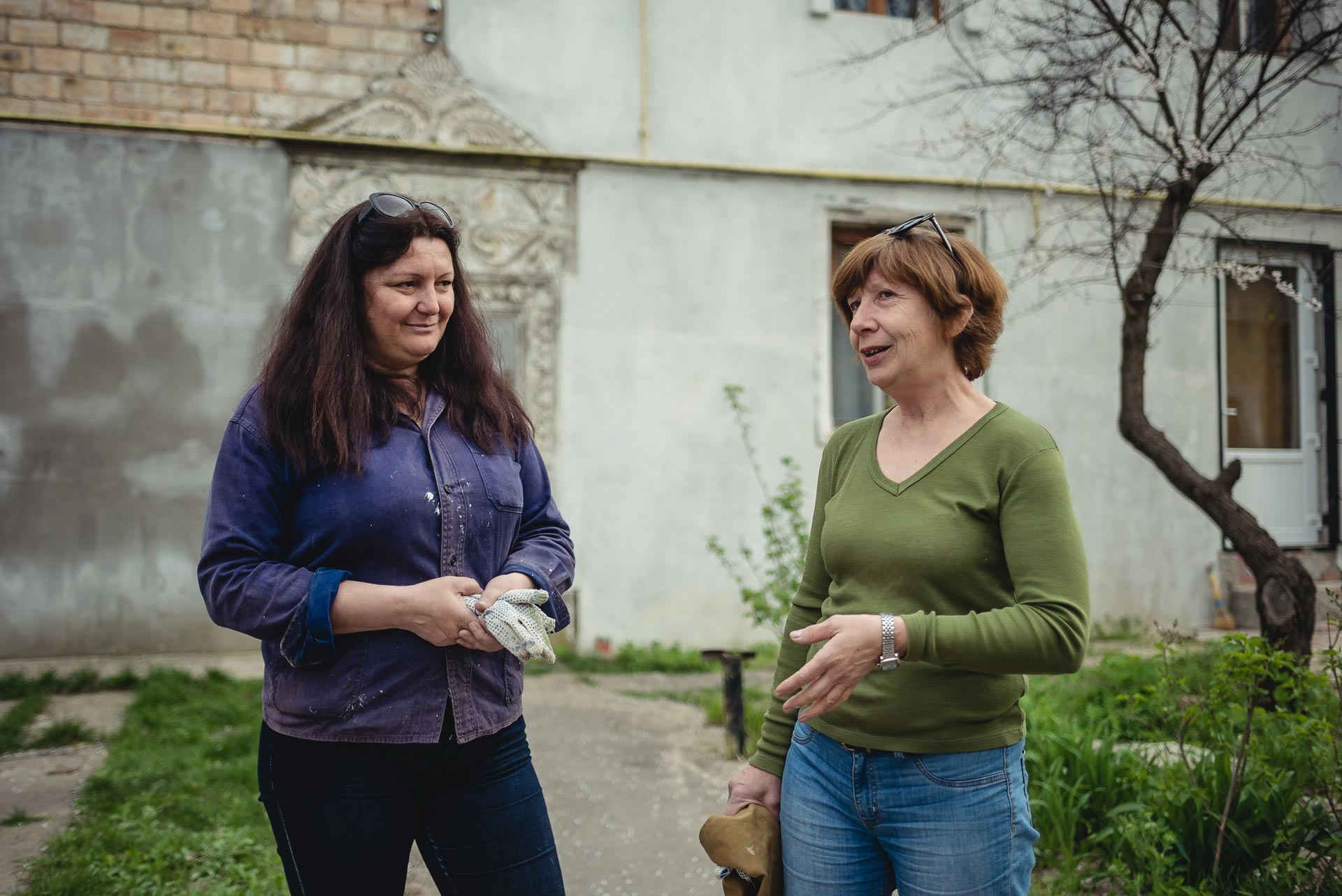
Tetiana and Diana vow that almost all of the “stone vyshyvankas” can be restored. Cleaning represents the most painstaking job, as each ornament is covered in layer upon layer of paint.
The project has saved several of Dovzhenko’s works already. As of December 2018, eight buildings have been restored. Little by little, “stone vyshyvankas” are coming back to life.
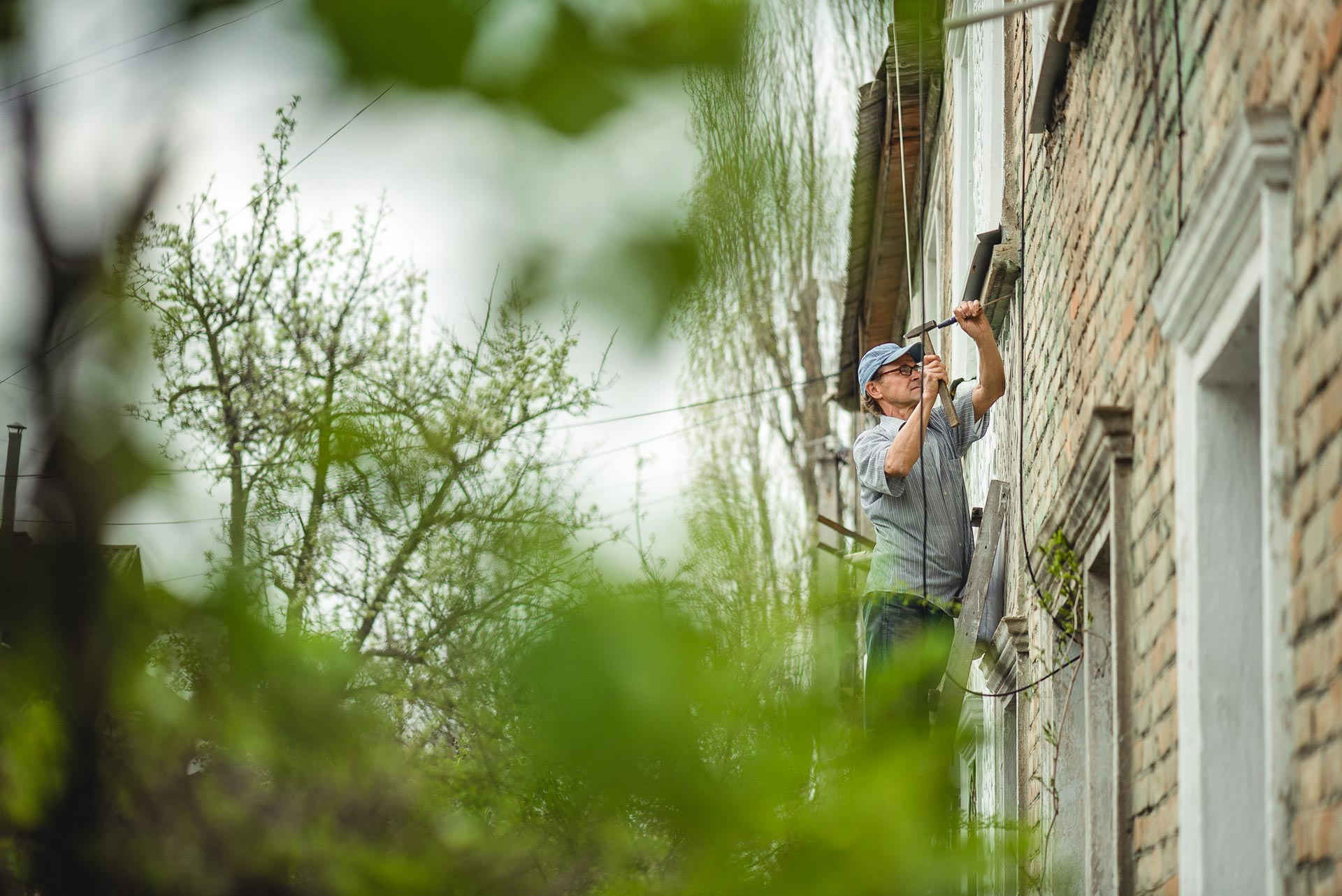
The first landmark protection service (thus dubbed by the volunteers) lasted several months. When an office building owner began the repairs on a facade, the activists offered to restore the “vyshyvankas”, so that the building would look the way the architects intended. Given this was one of the original and central blocks in Nova Kakhovka, the buildings here were whitewashed almost yearly. A lot of work went into clearing the grimy layers of paint. The results satisfied everyone involved.
The work that went into a set of decorated doors in the neighbouring building dedicated to a deceased soldier sparks awe.
— Here lives the family of one of our soldiers, Vitaliy Galeta. He was killed in the Anti-Terrorist Operation Zone. We decided to do the ornaments on this house for the Defender of Ukraine Day. We worked to have it ready for the Pokrova holiday.
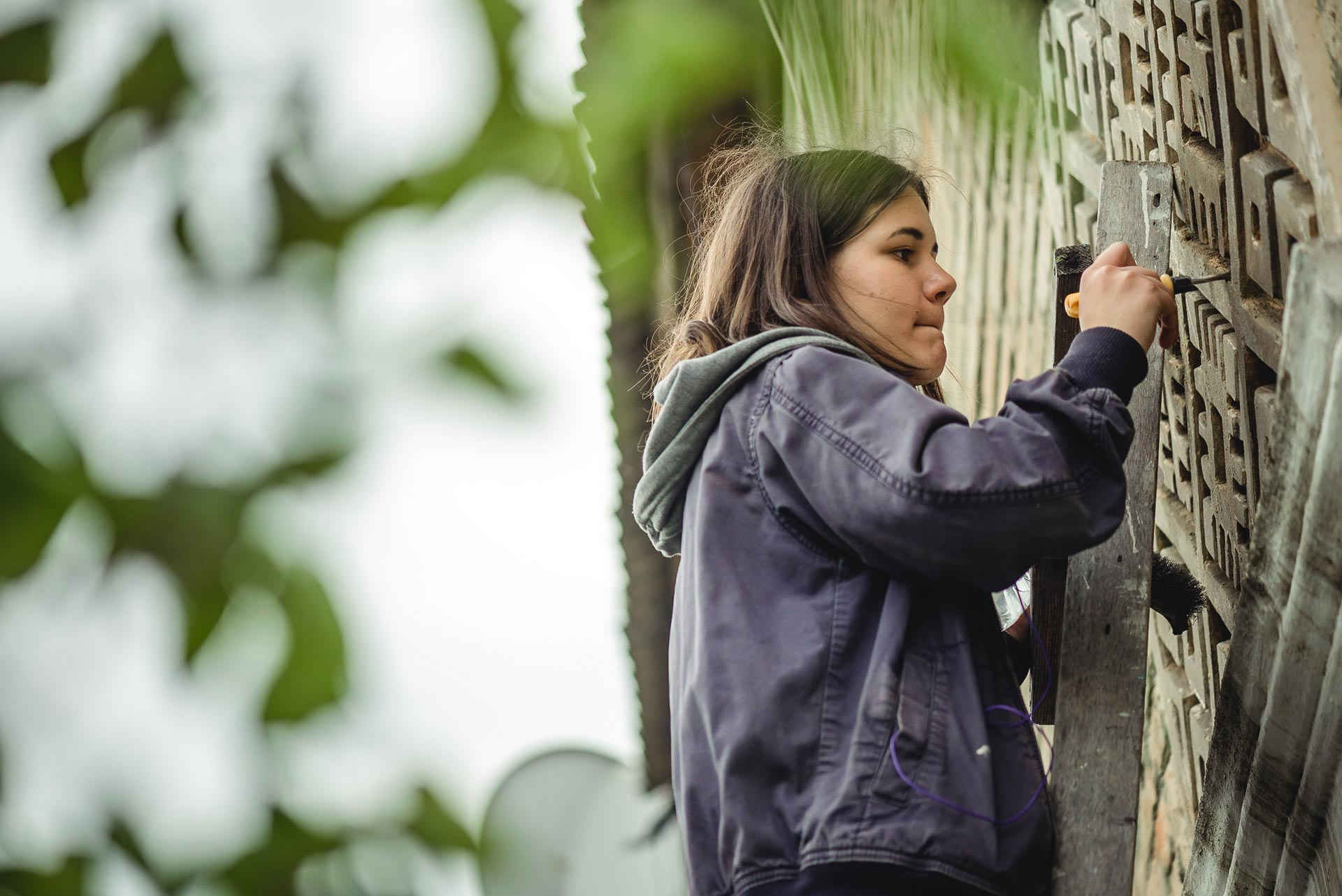
Joint efforts in reconstruction
Tetiana and Diana rejoice in the town’s support for their initiative. One of the channels of communication is a Facebook group called “Nova Kakhovka — Open-Air Museum of the Stone Vyshyvanka Monumental Art”, where they publish old photos of the town and announce gatherings. Local entrepreneurs help with all the necessary tools and materials, and other residents are becoming more and more involved in the restoration. Among them — both professional carvers and ordinary students.
— Some locals were skeptical of restoring the ornaments and thought that it’d be better to change the facades, fix up the roofs, but I reckon they can handle that themselves. We told them that students, teachers and school kids will be coming to restore the ornaments at their leisure. Then the inhabitants started to help out, bringing pies and tea, organising picnics.
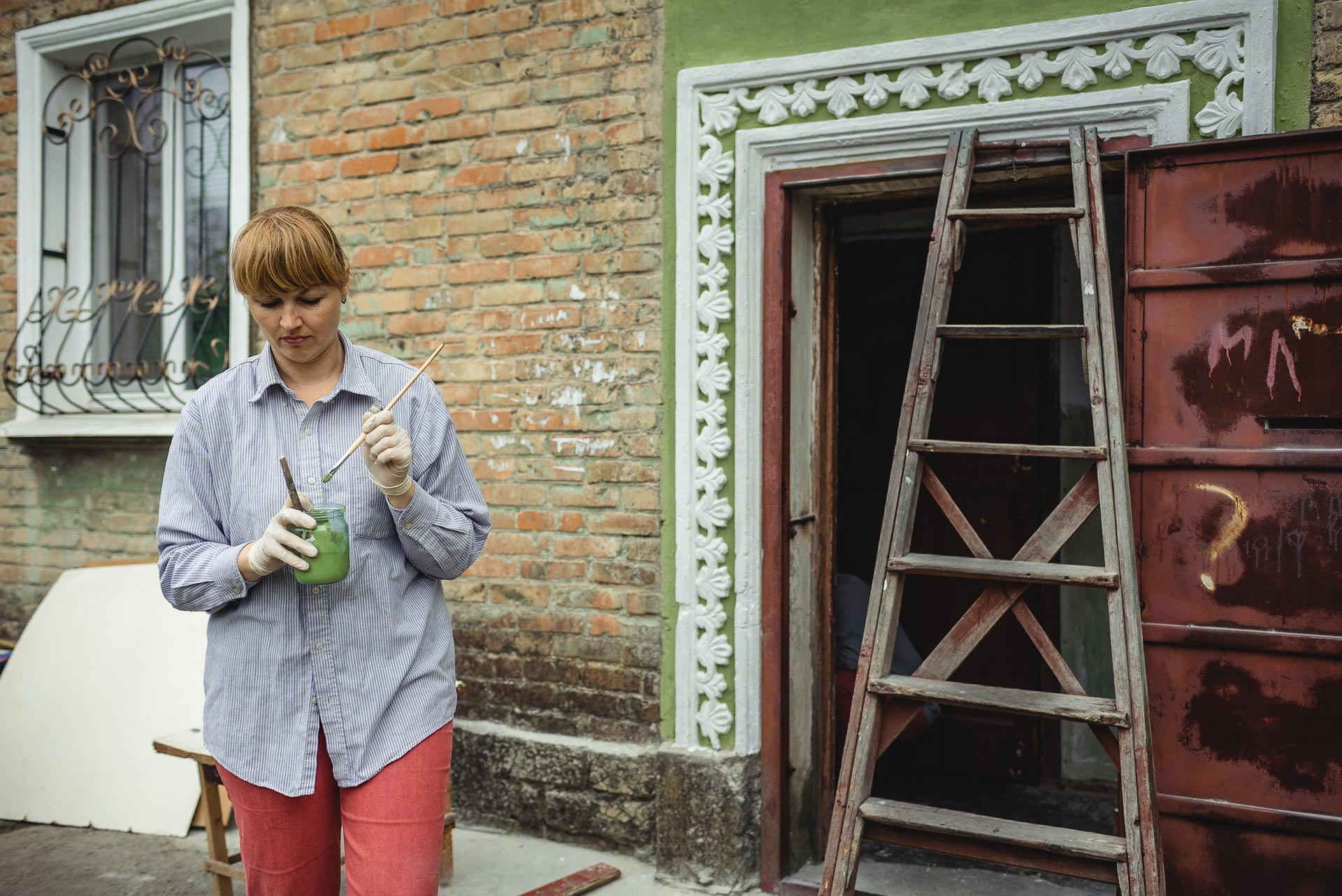
When we were working on the third house, a young man brought a bucket of facade primer and solvent, told us right then and there that he would be willing to help. Youngsters from a nearby house came up to us as well, wanting to be of use. We gave them tools, paint, ladders, and they cleaned up the ornament above their doors, and then the neighbouring one, too.
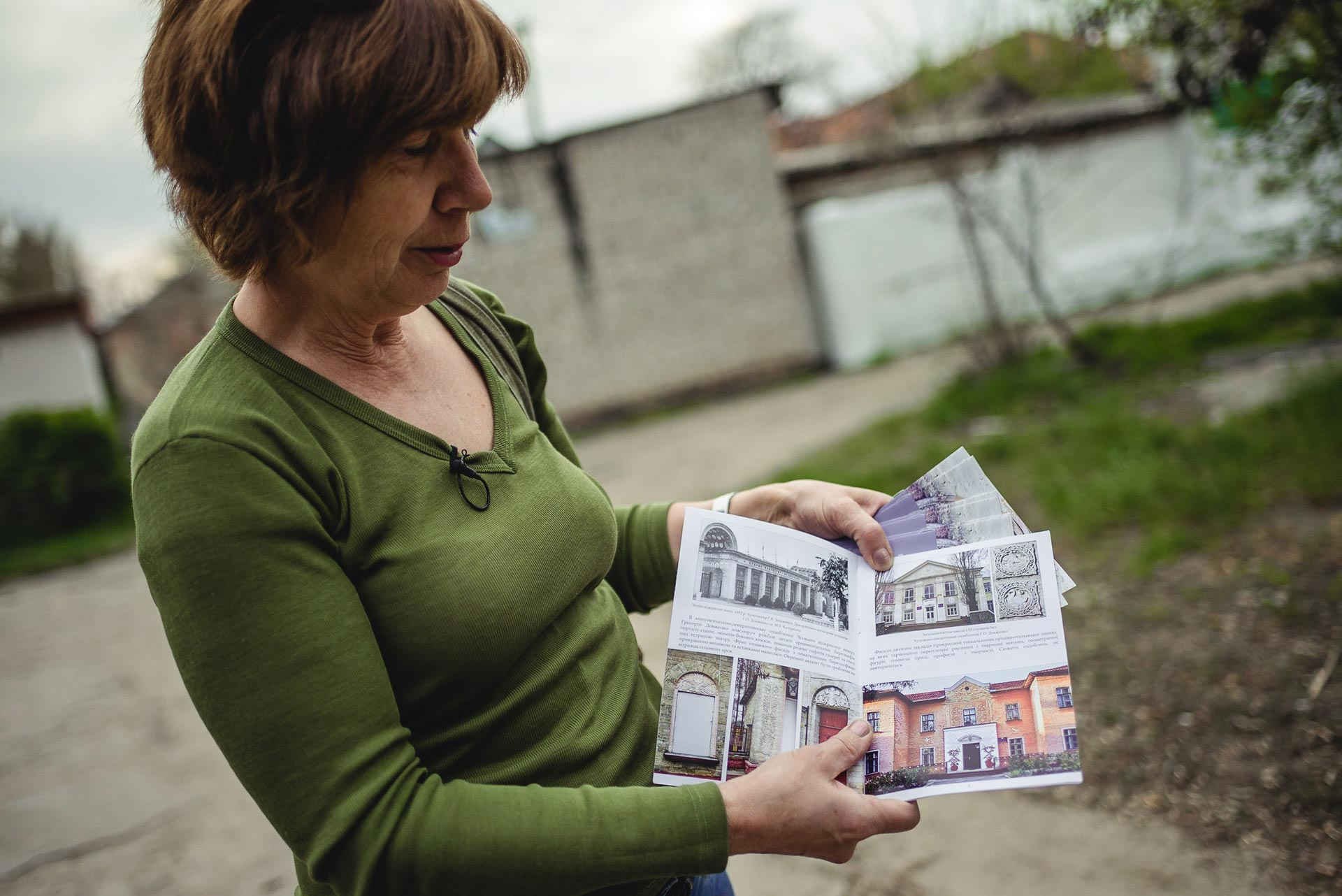
The new face of the town
Community activists are trying to involve as many people as possible to make the local architecture more attractive and recognisable. One of the ideas for the future is to organise camps for students from different universities, especially those majoring in architecture. Volunteers welcome anyone willing to work with them. They hope that soon enough they will manage to coordinate their efforts with experts from abroad — those who specialise in urbanism and monumental art.

Tetiana is convinced that “stone vyshyvankas” can play a key role in bringing people to Nova Kakhovka.
— I conduct tours — nowadays a lot of people come from Kryvyi Rih, Enerhodar, Odesa, Zaporizhzhia in order to see the “vyshyvankas”. And our town hall has organised tours too, showed people the embankment, the festive-looking buildings. Every visitor without fail wanted to see the “stone vyshyvankas”. And these buildings truly are remarkable.
I want to believe that Dovzhenko’s ornaments will continue to be a part of modern buildings and become a sort of business card for Nova Kakhovka:
— Ornaments can show up in different places — clothes, for instance. We were thinking that we could create games for kids, like cutting out the ornaments, painting them. You could teach students how to make solvent and carve. Overall, vyshyvankas have a wide range of applications: for example, in print, advertising and branding.
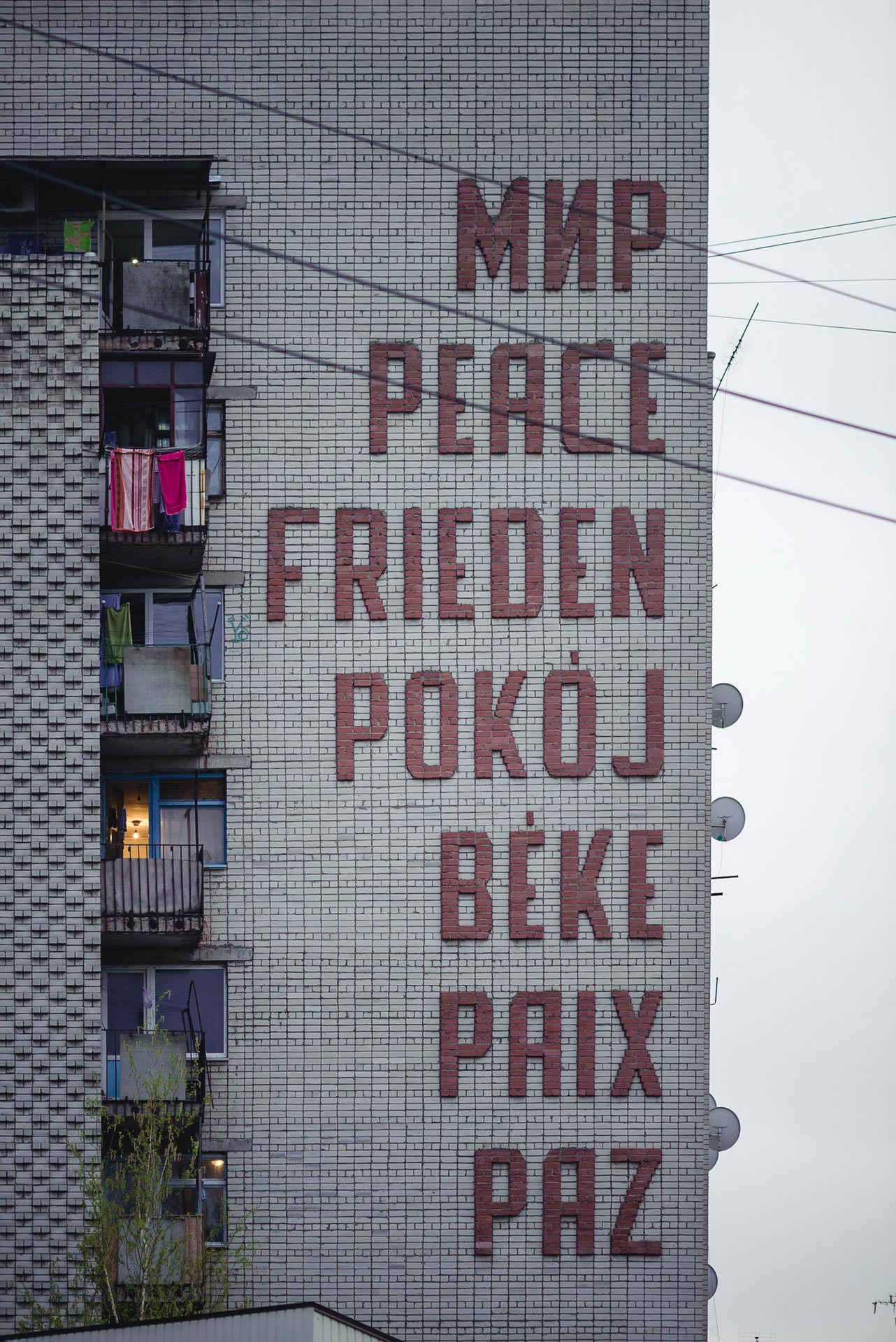
Changes: environment and people
As of today, the combined efforts of volunteers and Hryhorii Dovzhenko’s relatives have resulted in the publishing of illustrated materials bearing witness to the town’s history. Tetiana is glad that the architect’s son, Taras Dovzhenko, is writing about his memories of his father and their work in Nova Kakhovka. Step-by-step, the town’s community is becoming more and more informed about their cultural heritage, beginning to value and promote it. The number of fans of the “stone vyshyvankas” is growing. The activist believes that positive changes are already taking place:
— I hope that our activities are changing people’s habits. When we were filming near the embassy, I told the director about the Dniprobud. There was a woman sitting by the building, drinking coffee. She asked not to be filmed and then confessed that, after hearing my story, she paid attention to the building’s decoration for the first time in eighteen years, even though she’s worked there all that time. It’s our way of drawing people’s attention to the beauty they live in. And if it’s fine to decorate the facade of a community building, in this case, the entrances are also adorned. It’s as if a person, coming home tired to their wretched little flat, in fact arrives at a celebration though the building entrance.
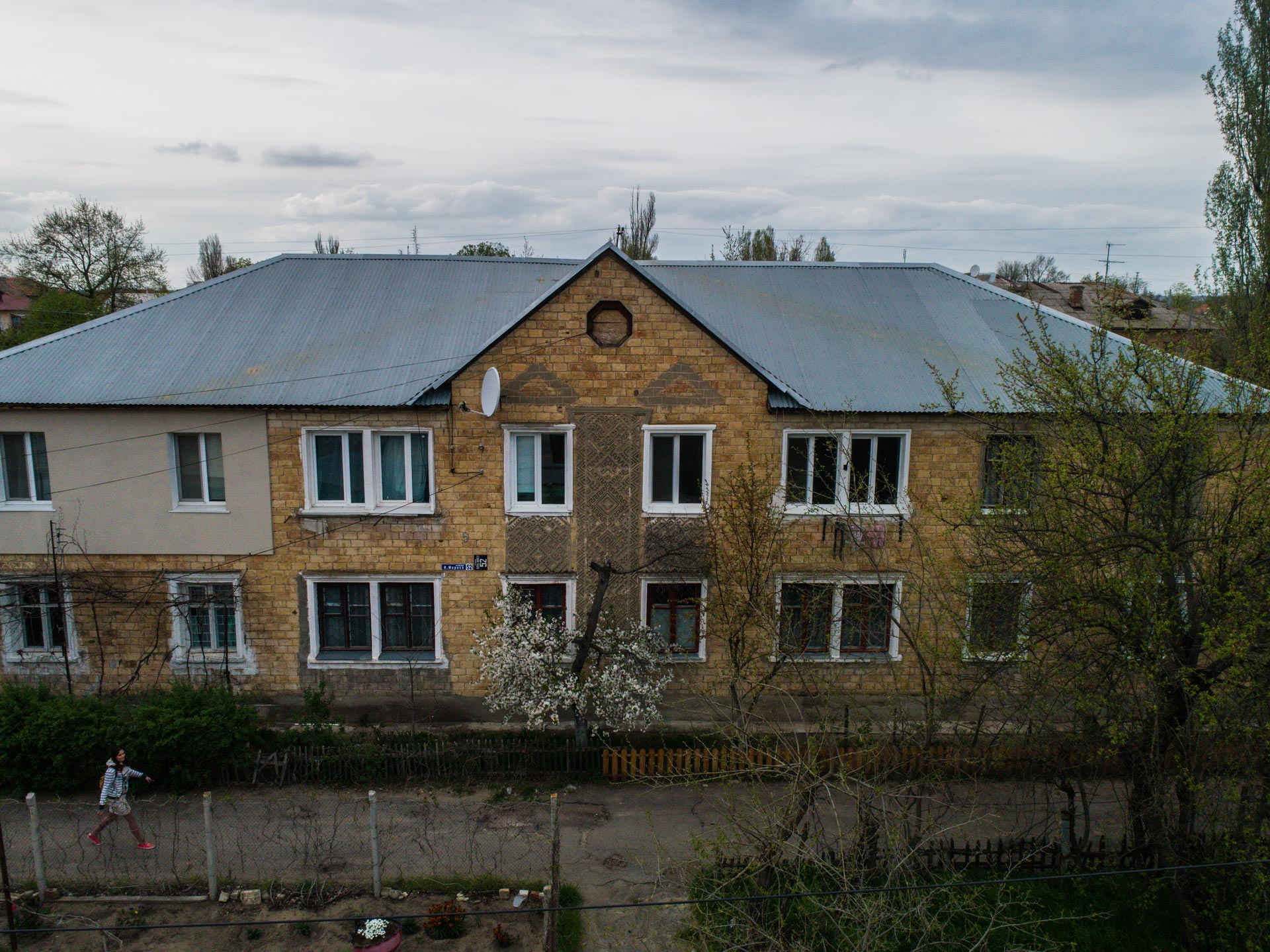
Thanks to these kinds of initiatives, volunteers are able to not only preserve valuable architectural landmarks, but also show Ukrainians the beauty of their culture.
— The artists who worked on the building of Dniprobud wrote that they wanted to portray Ukrainian art, and so the “stone vyshyvankas” are an expression of that. The artists themselves were wearing embroidered shirts and building a new Ukraine, and they believed that this would truly come to pass.

